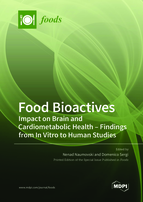Food Bioactives: Impact on Brain and Cardiometabolic Health – Findings from In Vitro to Human Studies
A special issue of Foods (ISSN 2304-8158). This special issue belongs to the section "Food Nutrition".
Deadline for manuscript submissions: closed (31 December 2020) | Viewed by 36750
Special Issue Editors
2. Functional Foods and Nutrition Research (FFNR) Laboratory, University of Canberra, Ngunnawal Land 2617, Australia
3. University of Canberra Research Institute for Sport and Exercise (UCRISE), Canberra 2617, ACT, Australia
4. Discipline of Nutrition-Dietetics, Harokopio University, 17671 Athens, Greece
Interests: green tea; plant polyphenols; catechins; EGCG; bioactives, nutrition; the effects of resveratrol supplementation on obesity in humans; plant bioactives; nutraceuticals
Special Issues, Collections and Topics in MDPI journals
Interests: nutrition and metabolic health; energy metabolism; obesity; type 2 diabetes; regulation of energy balance by the hypothalamus; Lipotoxicity and fatty acid metabolism; mitochondria dysfunction and insulin resistance; metabolic inflammation
Special Issues, Collections and Topics in MDPI journals
Special Issue Information
Dear Colleague,
The search for dietary patterns or food bioactive derivatives that may serve as a panacea for health issues has been a topic of interest for several millennia. It is not surprising that this trend in food research is continuing today particularly in relation to brain and cardiometabolic health, given the huge burden they pose on human health, with no geographical boundaries. Currently, there is an increasing demand for ‘pure’ and ‘clean’ foods as well as potent bioactive ingredients that can promote beneficial health outcomes. Several studies, including in vitro investigations, clinical trials, and observational studies related to food and nutritional patterns have already identified, proposed, and in some cases challenged the mechanisms of action of these foods and food ingredients.
Therefore, the aim of this Special Issue “Food bioactives and impact on brain and cardiometabolic health findings from in vitro to human studies” is to gather innovative, high-quality research manuscripts (letters to the editor, original research and review papers) on bioactive constituents of foods and dietary patterns which can directly impact upon brain and cardiometabolic health. We encourage the submission of manuscripts reporting on different areas of this research field, from the description of new conceptual ideas, mechanisms of action, and structural modelling to clinical trials and observational studies. This Special Issue is expected to provide up-to-date information on any aspects of bioactive compounds, with empirical emphasis on brain and cardiometabolic health.
Prof. Nenad Naumovski
Dr. Domenico Sergi
Guest Editors
Manuscript Submission Information
Manuscripts should be submitted online at www.mdpi.com by registering and logging in to this website. Once you are registered, click here to go to the submission form. Manuscripts can be submitted until the deadline. All submissions that pass pre-check are peer-reviewed. Accepted papers will be published continuously in the journal (as soon as accepted) and will be listed together on the special issue website. Research articles, review articles as well as short communications are invited. For planned papers, a title and short abstract (about 100 words) can be sent to the Editorial Office for announcement on this website.
Submitted manuscripts should not have been published previously, nor be under consideration for publication elsewhere (except conference proceedings papers). All manuscripts are thoroughly refereed through a single-blind peer-review process. A guide for authors and other relevant information for submission of manuscripts is available on the Instructions for Authors page. Foods is an international peer-reviewed open access semimonthly journal published by MDPI.
Please visit the Instructions for Authors page before submitting a manuscript. The Article Processing Charge (APC) for publication in this open access journal is 2900 CHF (Swiss Francs). Submitted papers should be well formatted and use good English. Authors may use MDPI's English editing service prior to publication or during author revisions.
Keywords
- Food bioactive derivatives
- Cardiometabolic risk
- Dietary patterns
- Psycho-cardiology
- Foods
- Functional foods








